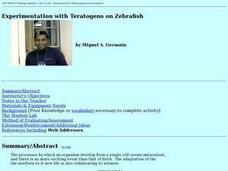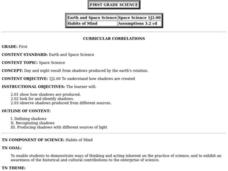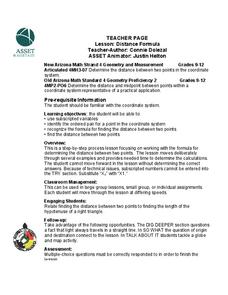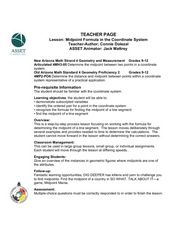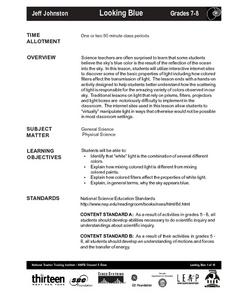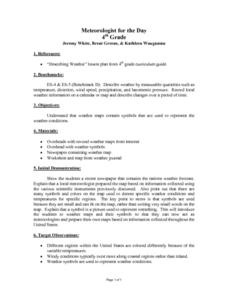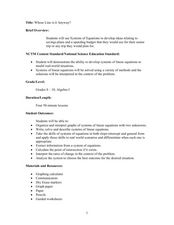Curated OER
Name That Point!
Students compare projectile point attributes, identify and classify points, and match projectile points to a chronology.
Curated OER
Attributes and Patterns with Buttons
Students work with attribute buttons in order to sort, create, and analyze patterns. Students practice identifying patterns and verbalizing the sorting rules and patterns they used. Sample assessments and rubric are provided.
Curated OER
Experimentation with Teratogens on Zebrafish
Students compare mitosis and meiosis with regard to chromosome number in parent cells versus daughter cells, types of cells produced, total number of cells produced, and the number of divisions. In groups, identify and differentiate the...
Curated OER
Day and Night
First graders study that day and night result from shadows produced by Earth's rotation. Students work to show how shadows are produced, look for and identify shadows and observe shadows produced from different sources.
Curated OER
Addition/Subtraction Strategies
Third graders recall all their addition and subtraction facts to 20. They use the relevant number strategy with whole numbers. Students are taught place value in relation to decimals, and identify 'which decimal is larger.' They...
Curated OER
Making Plastic
Students experiment to create a plastic solution. In this science instructional activity, students use sodium borax and polyvinyl alcohol to create their solution, then identify, discuss, and chart observations on the end product.
Curated OER
Distance Formula
Students calculate the distance formula. In this geometry lesson, students find the distance between two points on a coordinate plane. They identify the four different quadrants.
Curated OER
Midpoint Formula in the Coordinate System
Students calculate the midpoint of a line. In this geometry lesson, students identify the different parts of the coordinate plane. They use the midpoint formula to find the middle of segments between a pair of coordinates.
Curated OER
Newton's Three Laws of Motion Lesson Plan
Students explore Newton's three laws of motion using a variety of activities. In this physics instructional activity, students calculate the average speed of a vehicle they constructed using distance and time information. They identify...
Curated OER
Standard Linear Form
Ninth graders identify and describe the x-intercept as the place where the line crosses the x-axis as it applies to football. They create their own differentiations to reinforce the distinction between the x-intercept and the...
Curated OER
Two Terrains
Students compare two cell phone providers and relate those concepts to motion. In this algebra lesson, students identify the unknown in a problem using variables. They calculate the velocity, motion and displacement of different objects.
Curated OER
Investigating Linear Equations Using Graphing Calculator
Young scholars investigate linear equations using the Ti-Calculator. For this algebra lesson, students graph lines and identify the different quadrants on a coordinate plane. They identify ordered pairs used to plot lines.
Curated OER
Power House
Young scholars reflect, speculate, identify, research, and create a blueprint for renewable energy sources.
Curated OER
Meteorology (Condensation)
Second graders define condensation and evaporation. They identify and describe the steps in the water cycle. They ask questions to end the lesson.
Curated OER
Cost and Revenues
Students develop the key concepts of total, variable, fixed, average and marginal costs. The theory of using different business scenarios is applied to different situations for an extension to real life application.
Curated OER
Looking Blue
Young scholars participate in a research project that is exclusively using the internet. The author states that traditional labs are hard to conduct for a light lab. This one uses the internet with the intention that students can...
Curated OER
Meteorologist for the Day
Fourth graders examine the symbols used on weather maps. They analyze a newspaper weather forecast and identify and discuss the various symbols used on the map. Next, they prepare a weather map for their own city using the symbols...
Curated OER
Graphing Linear Equations Using Data Tables
Students review the Cartesian plane and the process of plotting points. In groups, students create tables, identify the slope and y-intercept, and graph the equation. Afterward, students perform the same process, only, individually. As a...
Curated OER
Linear Equations Data Tables
Students graph linear equations on a Cartesian plane. After describing data tables and their use, students explore how the information from a table can be used to create a line graph. They discuss reasons for plotting a minimum of...
Curated OER
Getting Started with the TI-Navigator™ System: What's My Rule?
Students explore linear relationships. In this sixth through eighth grade mathematics lesson, students explore the symbolic representation of verbal descriptions of mathematical rules defining the relationship between two variables.
Curated OER
Acceptance Sampling
In this algebra lesson, students sample food and identify acceptance sampling. They create specific plans to meet specific situations as they sample the food. There are 6 questions.
Curated OER
Properties of Logarithms
Students explore the concept of logarithms. In this logarithms lesson, students graph logarithms on their Ti-Nspire calculator. Students describe the shapes of their graphs by identifying slope, y-intercepts, and roots. ...
Curated OER
What's the Rub? It's All About Friction!
Students determine the coefficient of friction for different surfaces. In this physics instructional activity, students identify the factors that affect friction. They collect data and write a formal lab report.
Curated OER
Whose Line is it Anyway?
Learners solve systems of equations. In this algebra lesson, students identify the domain and range of each function. They use the slope and y-intercept to graph each line.


